Deanna Stover's Courses
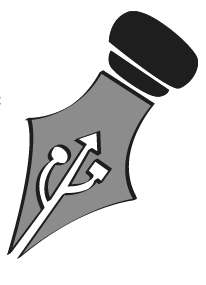
Deanna Stover is an Assistant Professor at Christopher Newport University. This website is a compilation of her syllabi since starting at CNU in Fall 2020.
Digital Edition Project
Rationale/Path Deadline: Wednesday, November 2nd by 11:59 pm
Percentage: 5% (required)
Sharing Days: Friday, November 11th; Wednesday, November 16th; Friday, November 18th
Final Digital Edition and Self-Assessment Deadline: Monday, November 22nd by 5:00 pm
Percentage: 20%
General Overview
Over the last few weeks, we’ve been reading about and looking at digital editions–most prominently the edition I’ve been working on with students of “The Yellow Wall-Paper” by Charlotte Perkins Stetson (or Gilman, as she is more commonly known). This project is all about addressing the peer review comments from The Recovery Hub for American Women Writers and coming up with new ways to imagine the edition, especially visually.
Assignment Breakdown
Path/Rationale - Wednesday, November 2nd by 11:59 pm
You must fill out the Path and Rationale form. Spend some time thinking about what you actually want to do. If you change your mind about something, you must resubmit the Path/Rationale via email.
To fill out the rationale, fill in the choice box with whatever components you put in Your Path and write a short description that explains 1) why it is important for the edition and 2) why you are interested in doing it. You should be specific and detailed in your responses in order to get full credit on the assignment. I will be taking off points for incomplete rationales.
I will not accept the other portions of this assignment until your path/rationale has been approved.
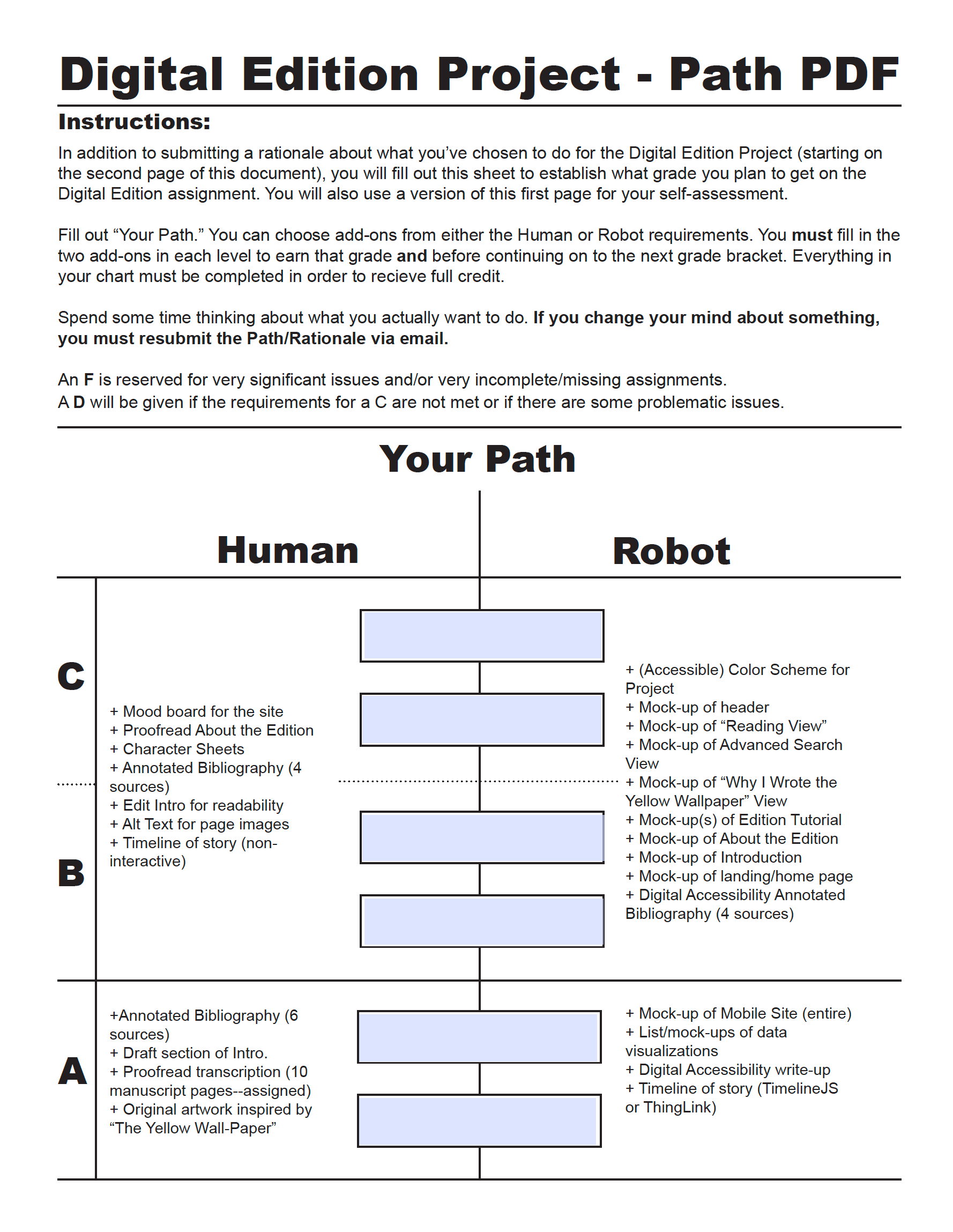

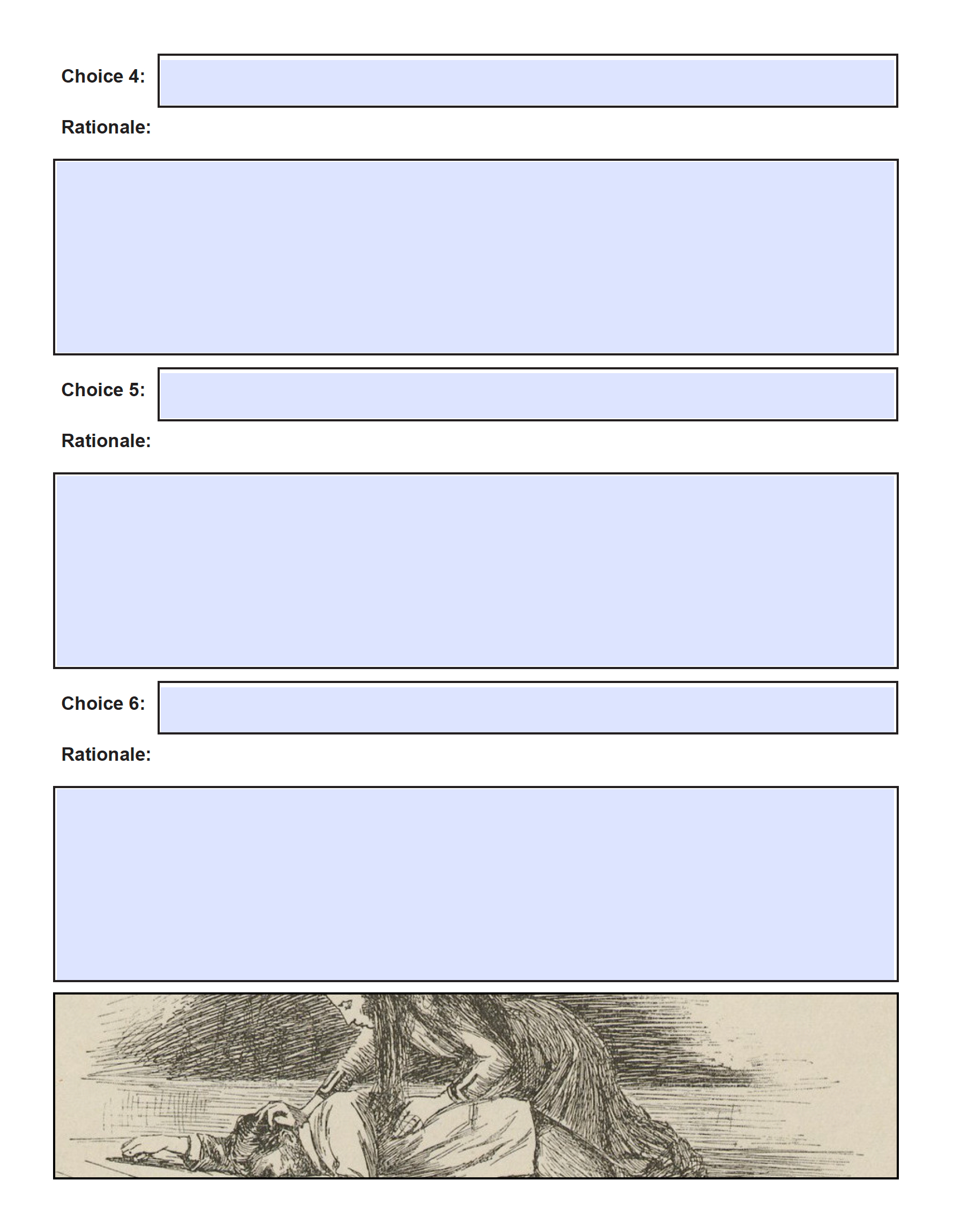
Sharing Days
You can sign up for a Sharing Day to earn 5 extra points on the assignment. No one is required to present during a Sharing Day, but this will boost a C grade to an 80, a B grade to a 90, and an A grade to a 100. (The five points will still apply even if you don’t quite reach the minimum requirements for a C, meaning if you get a D grade on the assignment but participate in the Sharing Day, you can get up to 70%).
In order to get the full five points, you must give a 3-5 minute presentation about your progress on the Digital Edition assignment. For this presentation, you must include a slide show with images. There can only be up to 7 presenters on a single Sharing Day, so do sign up early (through the Shared Google Drive) if you are interested and make sure you are prepared to present your works-in-progress on that day. You should also practice your presentation in order to stay under five minutes.
Any slide shows or materials you plan to show should be sent to me by 11:59 pm the day before you present.
Sharing Day #1: For Sharing Day #1, you should have started working on the Digital Edition project, but your project by no means needs to be complete. These presentations may focus more on the research you’ve done, the rough mock-ups you’ve drafted, or any planning documents.
Sharing Day #2: Projects shared during the second sharing day should show a substantial amount of progress on the assignment. While you can certainly discuss the research you’ve done and the resources you’ve gathered as well as any planning documents, you should also provide a glimpse at a substantial portion of your progress on the Digital Edition project.
Sharing Day #3: Projects at this stage should be mostly complete with very little editing left to be done. You should be primarily focusing on what nearly-final drafts you have.
Final Digital Edition Project/Self-Assessment - Monday, November 21st by 11:59 pm
In addition to submitting your final Digital Edition project, you will complete a self-assessment using a form that’s similar to the initial Path PDF. This Self-Assessment is crucial to your success on the project. I will not accept Digital Edition projects without a completed Self-Assessment form.
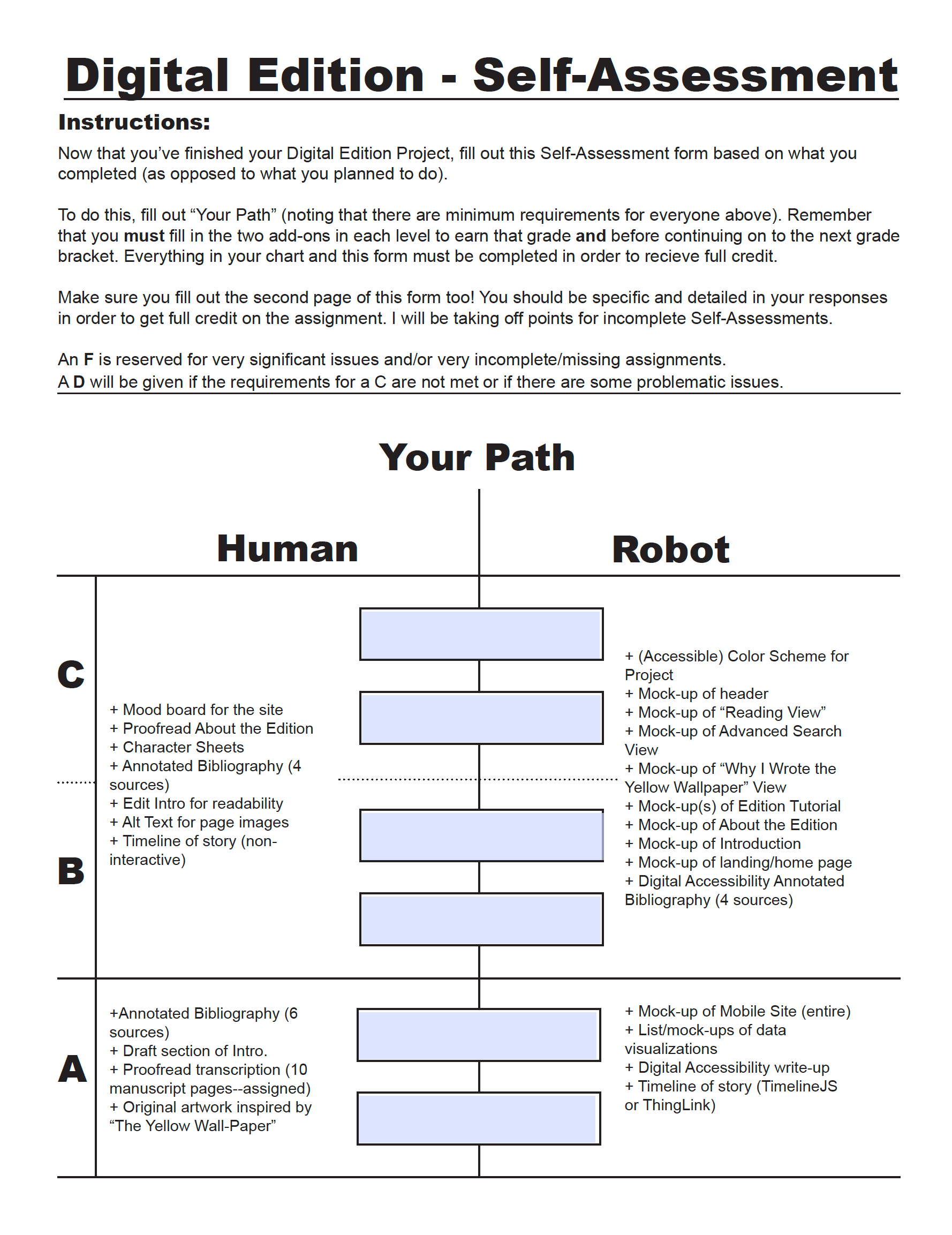
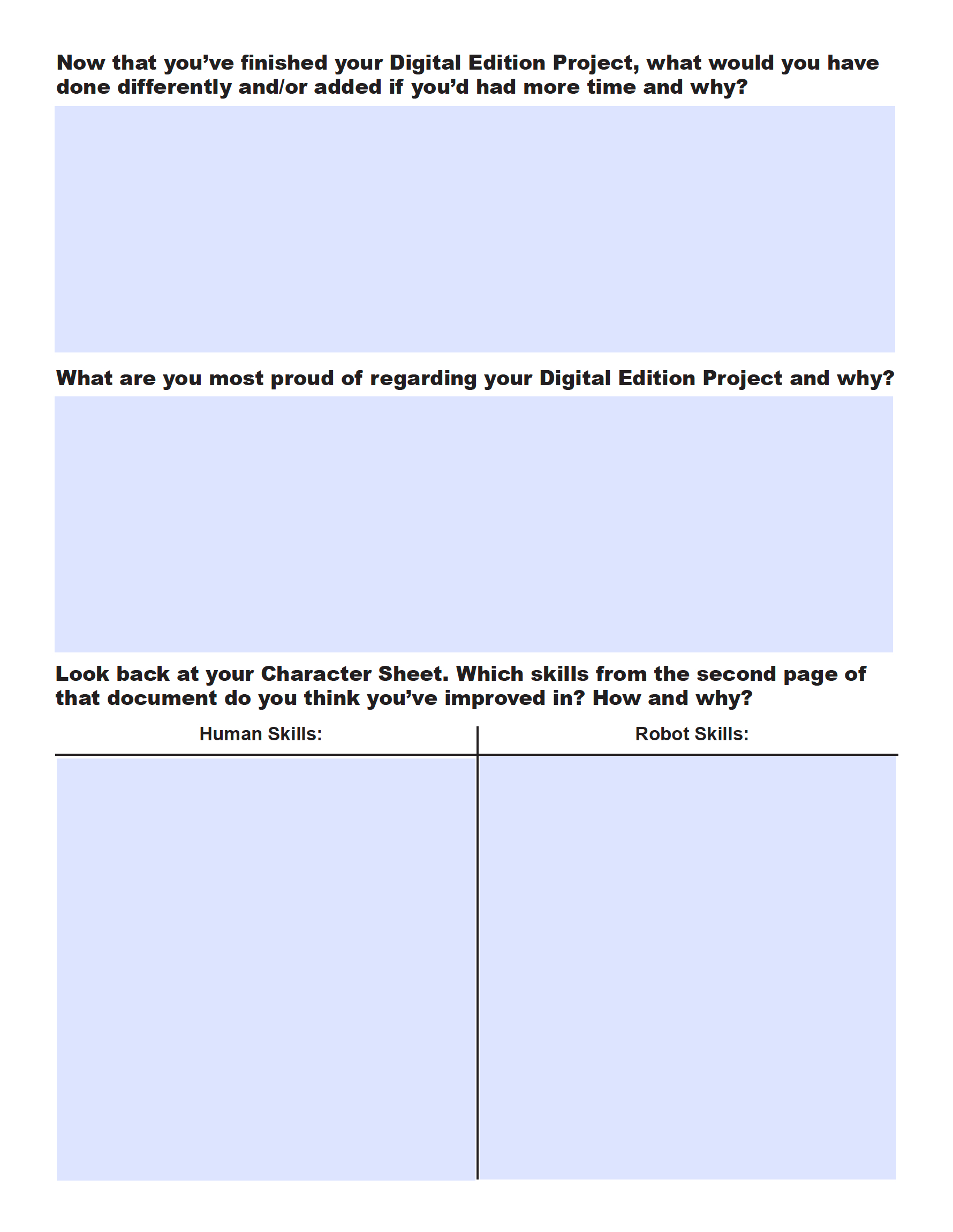
What do all the parts of the Path PDF/Self-Assessment Form mean?
Path PDF
Human Options
Mood Board for the site
For the mood board, you must find at least 10 images and make a sort of collage that invokes the feelings and features you want to convey and include in the site design. This might be fonts, insprational images and illustrations, colors, or anything else you can think of.
In addition to the mood board itself, you must include a key and a short description providing context for the mood board. The key should explain features included, such as what font(s) you’ve chosen and where they’re from (p.s. Google Fonts is a good place to start), where the images you’ve found are from, etc. The short description (150+ words) should explain the general mood you’re going for with your mood board and justify the inclusion of the 10+ artifacts you’ve compiled.
Proofread About the Edition
Read through the About the Edition (probably more than once!) and edit it. For this, you’ll need to copy the text from the site into a Word Document and make Track Changes to it. Please only choose this option if you feel comfortable with grammar and editing.
Character Sheets
For the Character Sheet option, you must create “Character Sheets” for three characters: the narrator, John, and Jennie.
The character sheets can be imagined however you like, but you must make a mock-up of what each sheet would look like on the website along with developing the actual content for the character sheets.
Annotated Bibliography (4 peer-reviewed sources for the C & B paths; 6 peer-reviewed sources for the A path)
You must find peer-reviewed sources about these topics, but you are not required to focus on one topic. That being said, if you plan to write a section of the introduction based on your research, you should stick to one of the below topics for at least 4 of your souces:
- Jane/Jennie Name
- Stetson/Gilman’s biography
- Stetson/Gilman’s racism and eugenicist beliefs
- Context about late nineteenth-century America (particularly in the context of “The Yellow Wall-Paper”)
- The illustrator, Joseph Henry Hatfield, and the original illustrations
- Scholarly interpretations of “The Yellow Wall-Paper”
The Annotated Bibliography can stack, so if you choose this option, you can have as few as 4 sources and as many as 10.
All entries for the Annotated Bibliography should be 150-250 words long and formatted according to MLA.
Edit Introduction for readability
Read through the Introduction (probably more than once!) and revise it to be more accessible to a high school and undergraduate audience. For this, you’ll need to copy the text from the site into a Word Document and make Track Changes to it. Afterwards, write a 200+-word summary of the changes you are suggesting and why.
Alt Text for page images
Write short descriptions of each page image for either the manuscript or periodical. Remember, Alt Text should be descriptive of what the image is while still being short and easily digestable. To turn this in, create a list of page numbers with matching Alt Text in a Word Document.
Timeline of story (non-interactive)
Either hand draw or use design software (Canva, Adobe products) to create a non-interactive timeline of the plot of “The Yellow Wallpaper” OR all of Gilman’s publications. Make sure it is well-designed and readable and could be displayed on a screen. For hand-drawing, consider using a tablet if you have one so that it is a digital “hand-drawn” artifact already (this will be helpful so that I don’t have to convert any drawings into a scalable image).
Draft Section of Introduction
If you choose this portion of the path, you must have chosen some kind of Annotated Bibliography. This is because any section of the Introduction must be based on research.
These are the sections of the Introduction you can write:
- Jane/Jennie Name
- Stetson/Gilman’s biography
- Stetson/Gilman’s racism and eugenicist beliefs
- Context about late nineteenth-century America (particularly in the context of “The Yellow Wall-Paper”)
- The illustrator, Joseph Henry Hatfield, and the original illustrations
- Scholarly interpretations of “The Yellow Wall-Paper”
If you would like to pitch another idea for the Introduction, please talk to me before submitting your Path PDF and Rationale.
Sections of the introduction should be 400 - 600 words long and based on your research. If you choose this option, at least 4 of your sources should relate to the topic of your introduction.
Proofread Transcription
For proofreading the transcription, you must compare the manuscript AND periodical transcriptions of the equivelant of 10 pages of the manuscript. I will assign you pages once I have graded the Rationale/Path PDF.
To turn in this, you must copy your assigned text for both the manuscript and the periodical into a Word Doc and use track changes to edit the document where appropriate. You must also write a short 200+-word reflection about the process of proofreading the transcriptions and what you learned.
Please only choose this option if you are very detail-oriented AND can read cursive.
Original Artwork inspired by “The Yellow Wall-Paper”
This can by any kind of original physical artwork (that we can reproduce digitally) or born-digital artwork that is inspired by the story of “The Yellow Wall-Paper” OR Gilman’s life. Please only choose this option if you are comfortable with art, but any medium is encouraged from detailed charcoal illustrations to quirky ink illustrations and cartoons to graphic design.
Robot Options
(Accessible) Color Scheme for Project
For creating a color scheme of a project, you want to keep an eye on accessibility. Color Safe can help. Make a document with all of the web colors you think should be a part of the color scheme, providing both a visual (that is, I can see the color) and the Hex Code for that color. You must also include a key for what each color should be used for (for instance, the background, the main text, the notes in the introduction, the highlighting in the edition viewer, the color of editorial corrections, etc.) and a short 200-word description of why you chose the color scheme that you did.
Mock-Ups
You can choose from several different kinds of mock-ups, but all should be detailed and well-designed. You can choose to hand-draw the mock-ups, but they should look polished and professional. You can also use design software to create the mock-ups, such as Canva or Adobe products. All mock-ups should include a key for what each element in the design is.
For the C and B brackets, you can choose any of these mock-ups:
- Mock-up of header image
- Mock-up of “Reading View”
- Mock-up of Advanced Search View
- Mock-up of “Why I Wrote The Yellow Wallpaper” View
- Mock-up(s) of Edition Tutorial
- Mock-up of About the Edition
- Mock-up of Introduction
- Mock-up of landing/home page
For the A bracket you can do a mock-up of the entire mobile site (in other words, what would the entire edition look like on a phone?). You will still need a key for these designs.
Digital Accessibility Annotated Bibliography
You must find 4 peer-reviewed sources about digital accessibility, particularly about how to best design a website and/or mobile site for members of the disabled community. All entries for the Annotated Bibliography should be 150-250 words long and formatted according to MLA.
List/Mock-Ups of Data Visualizations
For data visualizations specifically, you must create a list of ideas for what we could create data visualizations of and then sketch out (either by hand or using Canva or Adobe products) what those data visualizations might look like. You need to provide a key that explains what each of the data visualizations includes.
Digital Accessibility Write-up
If you choose this portion of the path, you must have chosen the Digial Accessibility Annotated Bibliography. This is because this write-up must be based on research. The write-up should be at least 500 words and cite all four sources and provide a plan for increasing the accessibility of “The Yellow Wall-Paper” edition. You should provide actionable steps for improving the edition for disabled users.
Timeline (TimelineJS or ThingLink)
You can make an interactive timeline of the plot of “The Yellow Wallpaper” OR all of Gilman’s publications. Make sure it is well-designed and readable and could be embedded in the site. To do this, either make a TimelineJS timeline (don’t worry, it just uses Google Sheets to create an interactive timeline) or make a hand-drawn or design-software-created timeline interactive by using ThingLink. If you would like to use ThingLink and it won’t let you make anything for free, please talk to me and I will be able to get you free access, but please be certain that you will use it (this option might cost $).
Self-Assessement Form
The first page of the self-assessment form is the same as the Path PDF (except for the instructions). Fill this portion of the form out based on what you actually did rather than what you initially planned to do (although, remember, every time you adjust your path, you need to email me with a revised Path PDF/Rationale).
The second page of the Self-Assessment asks you to be reflective and think about the final pieces you created for the Digital Edition project, particularly in terms of what you would have done differently or expanded on with more time, and what you’re most proud of.
Evaluation
You will receive the grade you choose if you have completed the appropriate brackets successfully, meaning that you have followed the directions for each section. So, essentially, you are being graded based on completion, but each of these components must be complete to count towards Your Path.
Late Work
I will be subtracting 5 points for every day your assignment is late unless you’ve been been given an extension.